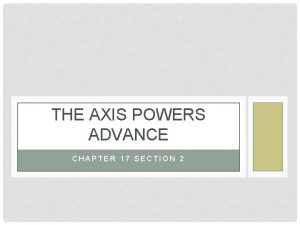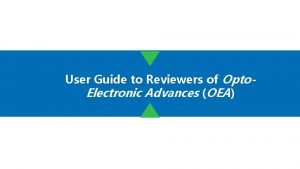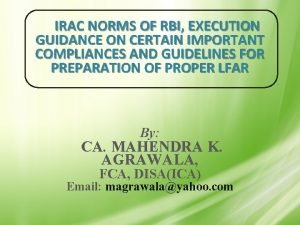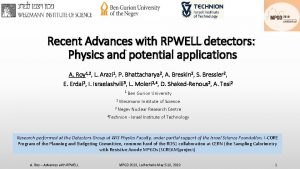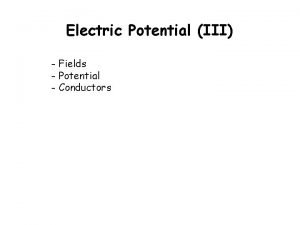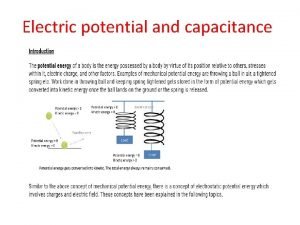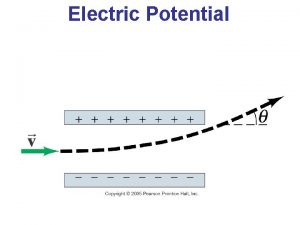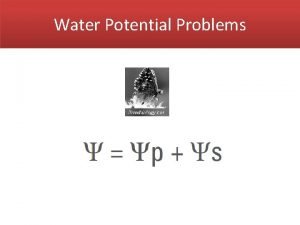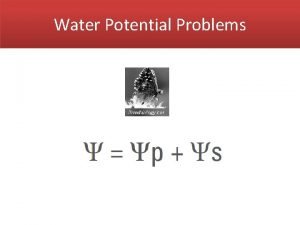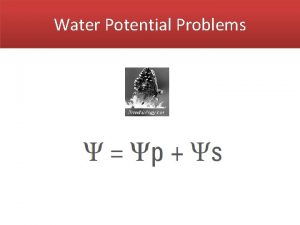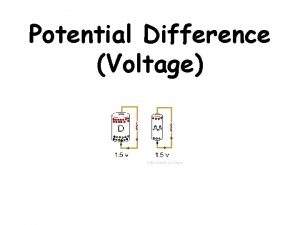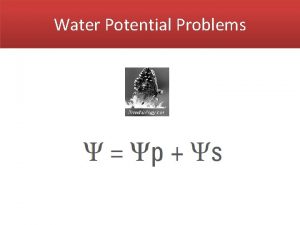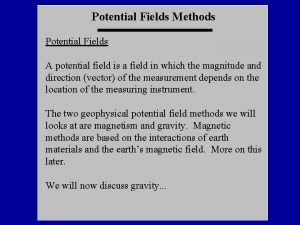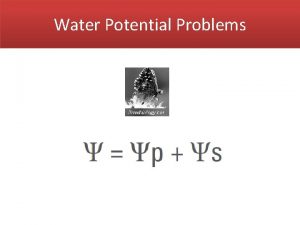IAEACN245 567 RECENT AND POTENTIAL ADVANCES OF THE



























- Slides: 27

IAEA-CN-245 -567 __________________________ RECENT AND POTENTIAL ADVANCES OF THE HGPT METHODOLOGY (Invited paper) Augusto Gandini Sapienza University of Rome, Italy International Conference on Fast Reactors and Related Fuel Cycles: Next Generation Nuclear Systems for Sustainable Development (FR 17) Yekaterinburg, Russian Federation 26 -29 June, 2017

IAEA-CN-245 -567 __________________________ Introduction Basing on a concept of importance conservation defined first in the field of radiation particles by Kadomtzev in 19571, a heuristically based perturbation theory method was first proposed in 1963 by Usachev for studies of reaction rate ratios 2. The method was then extended 3, 4, 5 to include a broader range of functionals in the linear and non-linear domain. In the following we shall call this method HGPT (Heuristical Generalized Perturbation Theory) to distinguish it from other forms of derivation, in particular, those based on variational and formal derivative techniques 6, 7, 8, 9, generally known as GPT methods. _________ 1. Kadomtzev, B. B. , “On the Importance Function in Radiation Transport Theory”, Dokl. An. URSS, 113, N. 3 (1957). 2. Usachev, L. N. , Atomnaya Energiya, 15, 472 (1963). 3. Usachev, L. N. , ZARISKI, S. M. , Atomizdat, 2, 242 (1965). 4. Gandini, A. , Journal of Nucl. En. , 21, 755 (1967). 5. Gandini, A. , “Generalized Perturbation Theory Methods”, Advances Nucl. Sci. Tech. , Vol. 19. , Plenum, New York, (1987). 6. Gandini, A. , Annals of Nuclea Energy, 24, 1241 (1997). 7. Stacey, W. M. , Jr. , “Variational Methods in Nuclear Reactor Physics”, Academic Press, New York (1974). 8. Lewins, J. , “Importance, the Adjoint Function, pergamon Press, Oxford (1965). 9. Cacuci, D. G. , Weber C. F. , Oblow, E. M. , Marable, J. M. , Nucl. Sci. Eng. , 75 88 (1980).

IAEA-CN-245 -567 __________________________ With this presentation two recent advances and a potential one, all based on the HGPT methodology, are described, namely: - A method for the on-line monitoring of a subcritical (ADS) system. - A method for detecting potential hot spots in a power reactor via SPND detectors. - A potential implementation of the GPT methodology in Monte Carlo. .

IAEA-CN-245 -567 __________________________ 1. The Subcriticality Monitoring method A problem connected with the operation of subcritical (ADS) reactors is posed by the ability of evaluating with sufficient precision their subcriticality level. In the following we shall illustrate a general approach to this problem, making use of a derivation of the zero kinetics equations relevant to these systems 10, 11. _______ 10. Gandini, A. , "HGPT Based Sensitivity Methods for the Analysis of Subcritical Systems", Ann. Nucl. Energy, 28, 1193 (2001). 11. Gandini. I, A. , "ADS Subcriticality Evaluation Based on the Generalized Reactivity Concept", Ann. Nucl. Energy, 31/7, 813 (2004).

IAEA-CN-245 -567 __________________________ Kinetic equations The power (P) and the effective neutron precursor densities (xi) following a perturbation d. B of the governing operator obey equations: (1) (2) The power P is normalized so that its value at initial conditions is equal to unity, i. e. : (normalized power) (3) whereas the effective neutron precursor densities xi are given by the normalized product of the precursor densities by their importance, i. e. : (i’th effective precursor density) ( = fission source) (4)

IAEA-CN-245 -567 __________________________ In the above equations a number of quantities with physical significance are defined, in particular: (effective prompt neutron lifetime) (generalized reactivity) (source reactivity) (5) (6) (7) The neutron importance function appearing in these expressions is governed by an adjoint equation associated with the normalized power at nominal conditions, i. e. , (g = energy units per fission) (8)

IAEA-CN-245 -567 __________________________ Quantity z multiplies the term (1 -P) at right side of the equation governing the normalized power. If we define the subcriticality coefficient (9) z may be defined as given by the ratio (10) Coefficient Ksub merges into Keff (the multiplication coefficient relevant to the fundamental eigenfunction) with the system approaching criticality. The quantity z may be very well considered as representing an appropriate subcriticality index.

IAEA-CN-245 -567 __________________________ The method Consider a change of a (calibrated) control rod position. This would correspond to an experimental reactivity value . The value of the experimental generalized reactivity associated with it could be assumed as the product of its calculated value by a bias factor, i. e. , (11) with the bias factor fb defined by a ratio (12) where the numerator corresponds to a control rod calibration value and the denominator to a calculated standard perturbation expression.

IAEA-CN-245 -567 __________________________ Likewise, the source experimental reactivity , associated with a given source change , could be represented by a ratio in terms of Ksub: (13) If we now consider changes of the control rod position and of the external source intensity such that the power level remains unaffected, this is reflected into the condition for which the experimental generalized reactivity and the experimental source reactivity compensate each other, i. e. , (14) Substituting the experimental source reactivity with the expression given above, we can obtain directly the value of Ksub: (15)

IAEA-CN-245 -567 __________________________ Conclusion The method proposed may very well be considered for safely determining the subcriticality level of an ADS system without significantly interfering with its normal operation. A numerical simulation exercise 12 was considered in view of an experiment on a subritical version of a TRIGA reactor. The exercise has demonstrated the potentiality of the method proposed. ________ 12. Carta, M. , et al. , “The Power Control Based Subcriticality Monitoring (PCSM) Method for ADS Reactors”, RRFM/IGORR Conference, Berlin, MARCH 2016.

IAEA-CN-245 -567 __________________________ 2. Hot spot identification method Through the use of the Generalized Perturbation Theory and of probabilistic inference techniques 13 a method has been developed 14 for the detection of possible hot spots during the operation of a nuclear reactor on the basis of on-line measurements of the neutron flux. These measurements are assumed to be made by using Self Powered Neutron Detectors (SPND), also named ‘collectrons’. The method had been conceived for its use in thermal reactors, in particular in PWRs. Its use could be also extended to fast reactors if efficient SPND detection techniques are developed for these systems. ________ 13. Gandini, A. , "Uncertainty Analysis and Experimental Data Transposition Methods", Handbook Uncertainty Anal. , CRC(1988). 14. Gandini, A. , "Hot Point Detection Method", Ann. Nucl. En. , 38 (2011) 2843.

IAEA-CN-245 -567 __________________________ The method takes into account the errors associated with the measurements. It also allows to evaluate the effect on the quality of the detections as a result of possible failures of the measuring instruments during the core life. Such evaluation may be useful for defining an adequate protection strategy in terms of quality, number and distribution of collectrons.

IAEA-CN-245 -567 __________________________ Theory Let us assume that a fixed number (N) of collectrons are positioned in the core of a given reactor. Let us then assume a number (M) of hypothetical hot spot positions. To simplify the presentation, without limiting its extension to more complex cases, we assume two-dimensional (x, y) geometry. For simplicity we also assume that at all, nominal or not, conditions at each position ‘m’ a constant value is maintained of the ratio (16) between the maximum and average linear power density.

IAEA-CN-245 -567 __________________________ Let us denote by a first threshold for the linear power density value relevant to each of the M possible hot spots considered, above which an attention warning would be triggered, and a second threshold above which the plant shutdown would take place. From the analysis of the detections (Qn) given by the collectrons, the possibility of the presence, or not, of a hot spot condition in one of the M hypothetical positions has to be evaluated in relation to the assigned thresholds.

IAEA-CN-245 -567 __________________________ The sensitivity coefficients (wn, m) used with this methodology represent the contribution of a unitary fission source, localized in a given fuel element (m), to the detection in each of the N collectrons. These coefficients form a vector (17) characteristic of each of the M possible hot spot positions. In a way, this vector may be considered as representing their 'signature'. Given a series of measurements (18) the search for a potential hot spot begins when one or more detections differ significantly, i. e. beyond fixed uncertainty margins, from nominal values.

IAEA-CN-245 -567 __________________________ In case the detections appear to deviate significantly from the nominal values, the candidate position, or positions, will be chosen among those for which the distribution of the components of the vector of sensitivity coefficients wm will be closer to the distribution of components of vector (Qex- Qo) relevant to the difference between the detected values and the nominal ones. The candidate position, or positions, for a potential hot spot will be then chosen among those for which, within a fixed range of uncertainty, is minimal the sum (19) where a 1 and a 2, m represent normalization coefficients.

IAEA-CN-245 -567 __________________________ Numerical exercise A numerical simulation has been made 15 relevant to a simplified, medium size PWR system project 16. The ERANOS code 17 has been used for the analysis. The calculations were made in diffusion approximation using a 15 group cross-section library. As regards the detector material in the collectrons, Co 59 has been chosen. ______ 15. Gandini, A. , et al. , Ann. Nucl. Energy, 50, 175 (2012). 16. Cumo, M. , Naviglio, A. , Sorabella, L. , “MARS, 600 MWth Nuclear Power Plant”, ANES Symposium, Miami, 2004. 17. Rimpaut, G. , et al. , “Physics Documentation of the ERANOS. The ECCO Cell Code”, CEA Technical Note RT-SPRC-LEPh-97 -001 (1997).

IAEA-CN-245 -567 __________________________ In Fig. 1 the positions of the elements containing the collectron devices are indicated together with the positions of the fuel elements in which the occurrence of a potential hot spot has been considered (limiting, for simplicity, to the first quadrant). Fig. 1. Core layout with a hot spot position (in black) among three detectors

IAEA-CN-245 -567 __________________________ For this simulation exercise, the ‘detections’ have been assumed corresponding to a set of quantities randomly sorted according to a Gaussian distribution law characterized by given calculated values ( ) and a 5% standard deviation. The fuel element position 8 has been chosen for the simulated hot spot.

IAEA-CN-245 -567 __________________________ In Table 1 the values of the sum (Sm) to be minimized are given for each fuel element position. It may be seen that the minimum value corresponds to position n° 8, as expected. Table 1. Values of the sums Sm Once the position of a possible hot spot candidate is identified, and sensitivity coefficients related to it are determined, we may use probabilistic inference methods for estimating the value of the fission neutron surge produced by the hot spot occurrence and the statistical error associated with it.

IAEA-CN-245 -567 __________________________ In Table 2 the results are shown in which the hot spot position and strength are estimated by probabilistic inference techniques, considering various degrees of collectron system degradation. We may see how the hotspot position and strength are being uniquely identified up to the failure of five collectrons. Table 2. Results from simulation (Hot spot at position 8)

IAEA-CN-245 -567 __________________________ Conclusion The results obtained with the simulation exercise show the method proposed may be used as a hot spot identification tool by fully exploiting the information available from a collectron detection system implemented in a nuclear reactor plant. This method may be useful also in a reactor design stage. In fact, an extensive analysis relevant to the distribution of collectrons and their failure sequences could allow identifying optimal configurations based on plant engineering and economic considerations. The applicability of the methodology proposed might be also considered for detecting ‘hot spots’ produced by channel flow blockages. A channel flow blockage would in fact produce a local temperature increase, which in turn would cause an alteration (in this case reduction) of the fission reaction rate due to the augmented absorption of the fertile material by the Doppler effect.

IAEA-CN-245 -567 __________________________ 3. Use of the EGPT Methodology with Monte Carlo A method under development 18 considers the use of Monte Carlo for GPT analysis, particularly in relation to ratios of functionals bilinear with the real and adjoint neutron fluxes (reactivity worths). The basic idea is the adoption of the Equivalent Generalized Perturbation Theory (EGPT)19 modality of GPT. This modality transforms the problem of solving inhomogeneous adjoint equations into that of solving homogeneous ones with the governing operators properly modified according to the functional (response) under investigation. ______________ 18. BURGIO N. , et al. , “The Monte Carlo GPT Methodology for the Analysis of Ratios of Functionals Bilinear with the Real and Adjoint Neutron Fluxes”, Ann. Nucl. En. , 106, 154 (2017). 19. GANDINI, A. , PALMIOTTI, G. , SALVATORES, M. , "Equivalent Generalized Perturbation Theory (EGPT)", Annals Nucl. En. , 13 (3), 109 (1986).

IAEA-CN-245 -567 __________________________ The method is based on the existing capability of the MCNP 6 code 20 by which it is possible to estimate the adjoint function by using the iterative mechanism of the KCODE modules 21 and by weighting a dedicated tally to obtain estimates of reactivity changes. To be reminded that also the Monte Carlo code SERPENT 22 allows to calculate as well sensitivity coefficients of a given quantity (response) with respect to system parameters. ________ 20. DENISE PELOWITZ, B. , “MCNP 6 User’s Manual”, LA-CP-13 -00634, Rev. 0 (2013). 21. KIEDROWSKI, B. C, ROWN, B F. , WILSON, P. P. H. , “Adjoint-Weighted Tallies for k -Eigenvalue Calculations with Continuous-Energy Monte Carlo”, LA-UR-10 -01824 (2010). 22. Aufiero, M. et al. , Annals of Nuclear Energy, 85, 245 (2015).

IAEA-CN-245 -567 __________________________ Let us consider a reactivity worth rc given by a standard perturbation expression: (20) Here B is the governing operator and dc. B its change due a system perturbation. Quantities f(c), B(c) and F(c) are relevant to the system state altered by the perturbation .

IAEA-CN-245 -567 __________________________ Along with the EGPT methodology, the change of the reactivity worth rc after an alteration of system parameters implying a change ds. B of the governing operator may be represented as a standard-like perturbation expression, i. e. : (21) The r. h. s, of this equation could be interpreted as the difference of the first-order reactivity changes induced by ds. B at perturbed conditions (by dc. B) and unperturbed ones. Preliminary calculation tests 18 have demonstrated the potentiality of the proposed method.

THANK YOU FOR YOUR ATTENTION
 1234
1234 Recent advances in dental ceramics
Recent advances in dental ceramics Write the highlighted digits place and value 567
Write the highlighted digits place and value 567 600 yuvarlanan sayılar
600 yuvarlanan sayılar Taly payroll
Taly payroll What is long term loans and advances
What is long term loans and advances Global oncology trends 2017 advances complexity and cost
Global oncology trends 2017 advances complexity and cost Decremental graded potential
Decremental graded potential Equipotential lines
Equipotential lines Electric potential energy
Electric potential energy Water potential equation
Water potential equation Sales potential vs market potential
Sales potential vs market potential Electric potential
Electric potential Potential of conductor
Potential of conductor Expression for electric potential difference
Expression for electric potential difference Electrostatic potential
Electrostatic potential Axis powers
Axis powers Advances in technology during wwii
Advances in technology during wwii Chapter 9 intellectual development of infants
Chapter 9 intellectual development of infants Advances in real-time rendering in games
Advances in real-time rendering in games Photodesintegration
Photodesintegration Opto-electronic advances
Opto-electronic advances Irac guidelines
Irac guidelines Advances in memory technology
Advances in memory technology Flaccid cell
Flaccid cell Understanding water potential
Understanding water potential Graded potential vs action potential
Graded potential vs action potential Graded potential
Graded potential
















